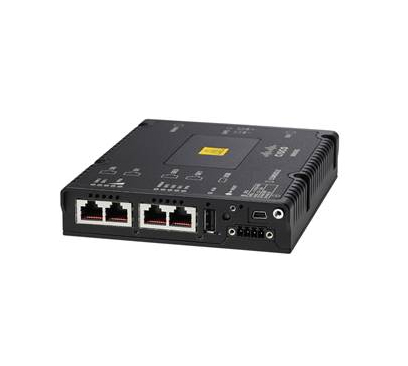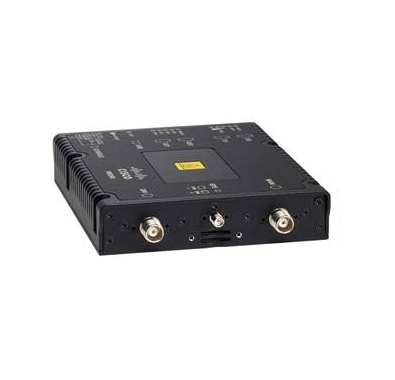 CISCO Cisco 809 Industrial Isr 4g/lte Multimode Att/canada
CISCO Cisco 809 Industrial Isr 4g/lte Multimode Att/canada
Pour une aide personnalisée ou une livraison plus rapide
+32 2 558 30 00
The Cisco 809 Industrial Integrated Services Routers is a compact ruggedized router designed for deployment in harsh industrial environments. The 809 is Cisco’s smallest multimode 3G and 4G LTE wireless router, making it an ideal solution for distribution automation and remote asset management across multiple industrial verticals. The 809 has an integrated 9.6-60 VDC power input and is designed to withstand hostile environments, including shock, vibration, dust, and humidity, and supports a wide temperature range (-40°C to +60°C and type-tested at +85°C for 16 hours). The IR809 brings together enterprise-grade wireline-like services, such as quality of service (QoS), Cisco advanced VPN technologies (i.e. Dynamic Multipoint VPN - DMVPN -, Flexible VPN - FlexVPN), and Multi-VRF for cellular, highly secure data, voice, and video communications and Cisco IOx, an open, extensible environment for hosting applications at the network edge.
The Cisco 809 Industrial Integrated Services Routers support the latest 3rd Generation Partnership Project (3GPP) Release 9 Category 3 LTE standards. They provide persistent, reliable LTE connectivity transparent handoffs between LTE and 3G networks.
The following models are available:
- IR809G-LTE-NA-K9: Multimode Cisco LTE 2.0 for carriers operating in LTE 700 MHz (band 17), 1900 MHz (band 2 PCS), or 1700/2100 MHz (band 4 AWS) frequencies; backward-compatible with UMTS and HSPA+: 850 MHz (band 5), 900 MHz (band 8), 1900 MHz (band 2 PCS), and 1700/2100 MHz (band 4 AWS).
- IR809G-LTE-VZ-K9: Multimode Cisco LTE 2.0 for carriers operating in LTE 700 MHz (band 13), 1700/2100 MHz (band 4 AWS), or 1900 MHz (band 25 extended PCS) frequencies; backward-compatible with EVDO Rev A/CDMA 1x BC0, BC1, BC10.
- IR809G-LTE-GA-K9: Multimode Cisco LTE 2.0 for carriers operating in LTE 800 MHz (band 20), 900 MHz (band 8), 1800 MHz (band 3), 2100 MHz (band 1), or 2600 MHz (band 7) frequencies; backward-compatible with UMTS and HSPA+: 850 MHz (band 5), 900 MHz (band 8), 1900 MHz (band 2), and 2100 MHz
- (band 1).
The Cisco 809 Industrial Integrated Services Routers offer a broad range of features for industrial and enterprise Internet of Things (IoT):
- Accelerometer and gyroscope: Monitor speed and angular momentum for automotive applications and detect tampering.
- GPS: Enables real-time location tracking of remote assets and geo-fence when used with IOT Field Network Director.
- Zero-touch provisioning: This provisioning uses network management tools, such as the IoT Field Network Director, and simplifying deployment of a secure network head-end using a Cisco Industrial Operations Kit.
- Security services: Services included area firewall, VPN, which requires no additional hardware or client software. This security service can, for example, intelligently redirect web traffic to the cloud to enforce granular security and acceptable use policies over user web traffic. With this solution, businesses can deploy the market-leading web security solution quickly and easily to protect assets from web-based threats, such as viruses, while saving bandwidth, money, and resources.
- 4G LTE wireless WAN (WWAN) data services: With enhanced data rates and improved latency (30 milliseconds or less), WWAN services provide an ideal way to supplement traditional wire-line services. These 4G LTE WWAN data services have average data rates with theoretical limits of 100 Mbps on the downlink and 50 Mbps on the uplink. Actual data speed depends on the service provider’s network. With 4G LTE data rates, the 809s offer a primary WAN link capable of running multiple services, including voice and video. The 4G LTE WWAN data services can also be used as a cost-effective alternative in areas where broadband wireline services are either not available or very expensive.
- Multiple-PDN (Packet Data Network): This feature allows the router to connect to different access point names (APNs) enabling traffic segregation. For example, public internet traffic can be kept separate from corporate traffic.
- 4G LTE multiple-bearer QoS for cellular: The 809s support 4G LTE multiple bearers, enabling differentiated treatment of traffic based on QoS policies. The QoS feature depends on the service provider’s ability to classify and enforce QoS policies and hence requires the providers to launch this service in their networks.
- Multi-VRF. The 809s support multi-VRF feature that allows customer to segment and isolate traffic based on their applications requirements.
Business Benefits and Application Examples:
Industrial customers are looking for real-time monitoring and control of industrial assets to drive higher operational efficiency.
Utilities
Utilities are looking to have the ability to monitor thousands of miles of electrical or water infrastructure often located in harsh environments through 3G and 4G cellular networks to provide remote assets monitoring, and reliable and secure supervisory control and data acquisition (SCADA) traffic backhauling. Devices that enable this connectivity need to be able to be remotely monitored and configured, and need to support legacy serial interfaces to interconnect with legacy monitoring devices.
Oil and Gas
Oil and gas companies have the need to monitor pipeline infrastructure across wide geographic areas and remote locations using 3G and 4G cellular networks to collect data from remote terminal units and securely transport SCADA traffic to a Network Operations Center.
Transportation
Highways and transportation agencies require reliable always-on communication between speed cameras, monitoring cameras, ticket terminals, etc. Wireless devices to support such a continuous communication need to support 3G and 4G networks to assure good wide coverage, support continuous operation in very harsh environment, and be very compact for deployment in roadside cabinets, as well as support serial interfaces to existing legacy devices.











 Livraison GRATUITE.
Livraison GRATUITE.

